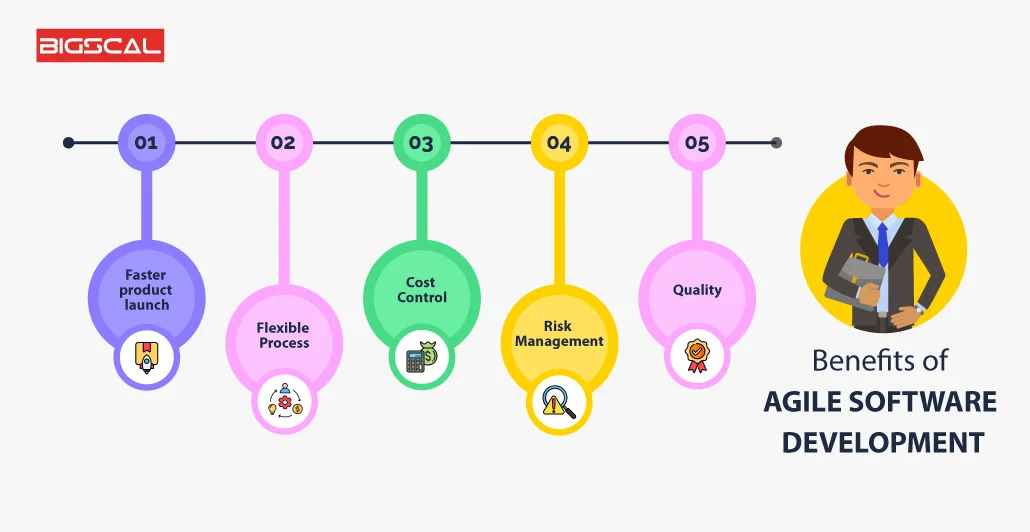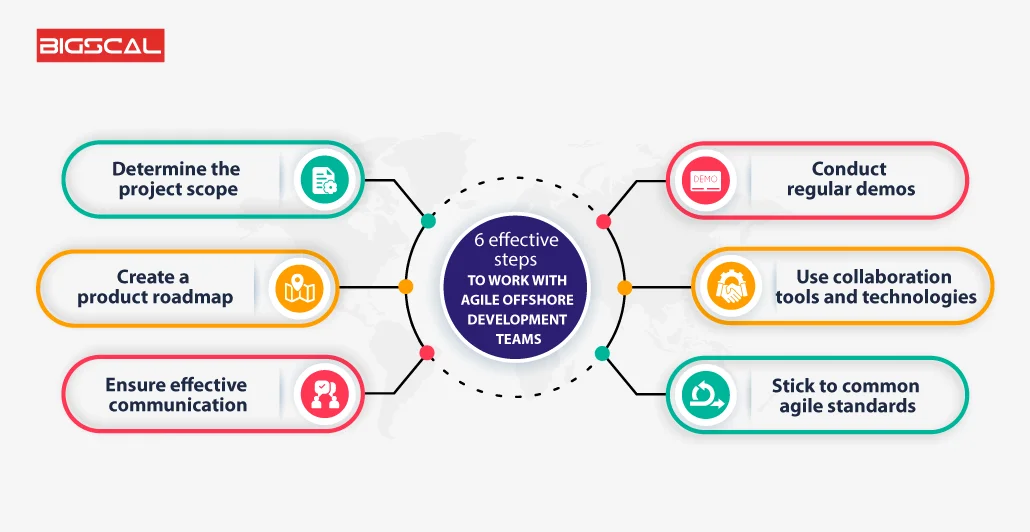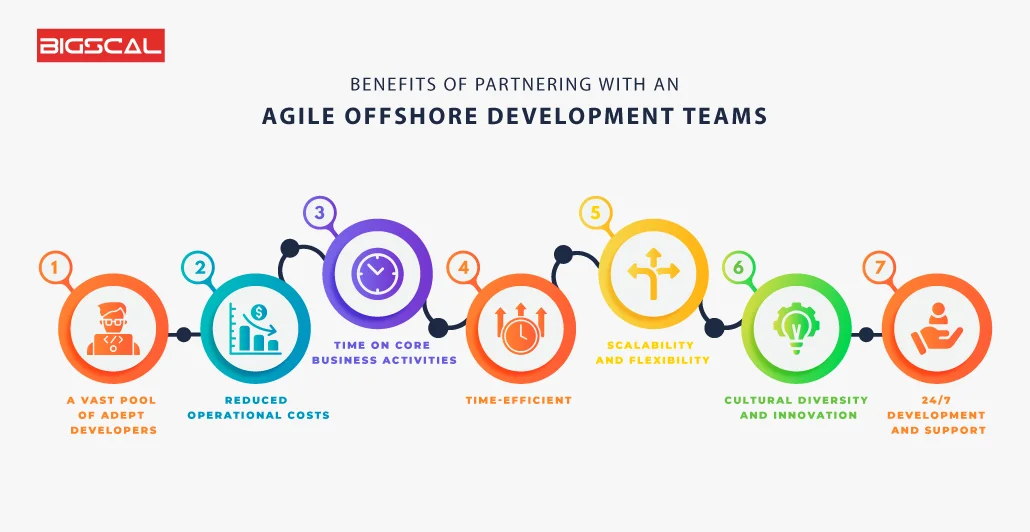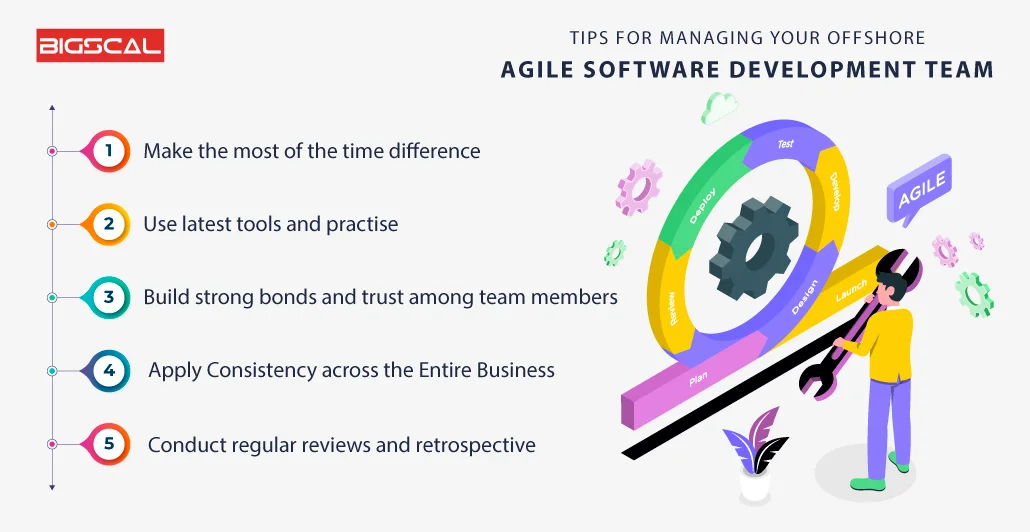A Practical Guide to Finding and Working with Agile Offshore Development Teams
Quick Summary: In this blog, we explore strategies for effectively collaborating with agile offshore development teams. We delve into the benefits of agile software developments and focus on overcoming challenges such as communication and time-zone differences. We will also highlight the benefits of leveraging agile offshore teams including increased flexibility, access to diverse talent and cost efficiency.
Introduction
The hiring of agile Offshore Software Company is becoming increasingly popular nowadays. This approach requires a handful of product engineers in some faraway land to construct a robust product based on your requirements.
It helps businesses deliver high-quality products and reduce their budget and time to launch the product in the market.
Although agile frameworks are commonly used for in-house development, they are not as widely adopted as they could be. This is because agile software models require strong collaborations among the development teams.
As Agile projects require extensive coordination in each project, many companies need help finding it possible to work with agile offshore development services or build an agile development team in a different geographical location.
Gladly, if you prepare correctly, you can work effectively with an experienced agile offshore development team and come up with innovative and high-impact solutions.
As a result of COVID-19, IT services spending will reach around 1.2 trillion U.S. dollars worldwide in 2022, representing an increase of 11.2 per cent over 2020. Additionally, it impacted IT-outsourcing market revenues, which are expected to reach 413.7 billion U.S. dollars by 2022.
In this blog, we will discuss how to work effectively with an agile offshore software development company and its benefits.
Let’s get started!!!!!!!!!

Introduction to Agile
A quick and dramatic rise in productivity and innovation has resulted from agile’s popularity. Furthermore, it is the practice of splitting large projects into smaller projects called iterations.

Additionally, it helps the development team to access the project workflows and provides satisfaction to clients through continuous product delivery.
The most common methodology and framework that incorporates agile philosophy is Scrum, chosen by 84% of agile offshore development teams.
On average, there are 7 members in the scrum team. Furthermore, the scrum team includes a Scrum Master, Software Developers and a Product Owner. Additionally, Scrum is an excellent method for offshore development to build software as it does not require subordinate teams or hierarchies.
This allows the team to plan out their activities in advance, offering more flexibility to all participants.
Benefits Of Agile Software Development
Let’s explore the benefits of agile software development:

1. Faster product launch
In Agile, the project is divided into smaller iterations, which greatly increases the time-to-market. Furthermore, you can launch your MVP at the end of each iteration or begin building a user base after iterating.
2. Flexible Process
This agile development methodology is based on adapting to changes. It adapts quickly to changing market trends and dynamic user requirements. Furthermore, Agile can embrace mid-project ideas to improve quality and relevancy.
3. Cost Control
Agile demands that you pay only for the services you need. In this way, the client can opt to omit features halfway through the development process if he realizes the features he initially requested are no longer relevant. By doing so, they can launch the product more quickly and at a reduced cost.
4. Risk Management
Agile allows stakeholders and users to use and test the product at the earliest possible stage. By identifying any pitfalls during the development process and taking action accordingly, one can avoid them in the future.
5. Quality
Every stage of the agile methodology is subjected to rigorous testing. In addition to ensuring superior product quality, this process reduces the time spent evaluating the product.
An Overview Of Agile Development And Offshoring
You should move on to the next stage once you get a clear understanding of your project’s concept, purpose, and idea. Onshore, offshore, and nearshore agile software development teams can be chosen based on the type of project.
By hiring a team based in your region, you ensure that they have a similar culture and language to yours. Hiring a development team in a nearby country is referred to as nearshoring.
Last but not least, outsourcing means hiring software developers from abroad. Organizations are increasingly leaning towards employing an offshore software development team.
6 Effective Steps To Work With Agile Offshore Development Teams
Often, outsourcing offshore agile development to geographically dispersed teams creates more complexity that hampers communication and collaboration between the teams. Below we have highlighted a few agile Outsourcing and offshoring practices that help businesses to simplify product development.

1. Determine the project scope
Before collaborating with the offshore agile development team, it’s essential to establish a scope of work document. Furthermore, this document outlines the project goals, tasks and timeline and expected outcomes clearly and concisely.
Based on the SOW, the entire software project is divided into smaller tasks. Each task is called an iteration and each task must be completed within a specific timeframe or deadlines. Furthermore, the client and development team can take this document for reference purposes.
Overall, it helps all the team members to execute the development workflows in an organized way and even prioritize the changes based on customer feedback and other factors.
2. Create a product roadmap to execute the work efficiently
Once you created the SOW document, the next step is to split each task into specific time intervals to prepare product strategies and a roadmap.
Furthermore, this roadmap provides a complete list of all requirements needed to construct an application.
Also, a product roadmap provides a clear understanding of the development approach of all the members of the agile offshore development team.
Additionally, this SOW document is flexible and can be modified throughout the development cycle based on user feedback and requirements etc.
3. Ensure effective communication among team members
Regular and effective communication is the prime reason that contributes to the success of the agile development approach. Therefore, it is crucial to conduct regular meetings to improve communication among team members when working with agile offshore development teams.
Below we highlighted some most common meetings, including:
Planning and review meetings for Sprints: These meetings aim to assess the project’s progress and compare it to the Sprint goal set during the planning stage. Furthermore, the team prepares for the upcoming Sprint, and any pending tasks from the Sprint backlog are discussed.
- Release planning meetings: The development team creates the release plan. It includes complete information to take the project from one point to another. Additionally, it highlights all the potential risks and ways to deal with them.
- Regular stand-up meetings: In this, team members held 15-20 minutes calls every day. Here, the team discusses the specific work plan for that particular day.
- Retrospective meetings: Such meetings allow team members to discuss their working culture and recommend any changes or improvements if required.
- All the team members can use various platforms such as Skype, Zoom, Google Meet, Slack, and even WhatsApp to conduct the meetings.
4. Conduct regular demos
This is a best practice to improve communication while working with an offshore development company. In addition, a demo is fundamentally an example of a final product that has been achieved after a series of iterations.
Furthermore, it enables clients to view the product performance so far and helps them to give feedback and suggestions based on the performance.
In this demo, the team looks back at the last iteration, pinpoints the positive and negative points, and develops smart solutions.
Overall, this approach involves solid and effective collaboration among the team members to get positive outcomes.
5. Use collaboration tools and technologies
Leveraging collaboration tools and technologies is crucial when working with agile offshore development teams.
Furthermore, agile teams can use various collaboration tools to simplify their work processes and maintain accessible communication among team members.
Collaborative tools cannot fully replace the idea of sitting and working together in the same place, but they definitely boost teamwork. A few examples of collaboration tools include Wikis, Trello, JIRA, and Slack.
6. Stick to common agile standards
Generally, the agile software development approach uses some common practices. Furthermore, these include continuous integration, certain coding criteria, and smart bug tracking and design patterns.
It is crucial to follow these development practices when managing agile offshore development teams.
Additionally, remember to use a source code service for smooth communication and collaboration between the internal and offshore team members.
By utilizing a source code service properly, one can discover project vulnerabilities, and design flaws, and even verify crucial security controls.
Benefits Of Partnering With An Agile Offshore Development Teams
Let’s explore the benefits in detail:

1. A vast pool of adept developers
By working with agile offshore development teams, you get unlimited access to a huge pool of proficient developers who are updated with the latest technologies and market needs.
Additionally, the experts bring a great deal of understanding and expertise to your project, ensuring a high-quality outcome. By working with them, you can be ensured that your work is in good hands.
2. Reduced operational costs
Working with an internal agile team leads to high operational costs. Also, you need to spend on a proper working setup, employee benefits, hardware costs, insurance etc.
Hiring a remote team requires your upfront investments, which in turn are the exclusion of any additional or hidden charges.
3. Time to concentrate on core business activities
The other added value of an offshore agile team is this feature.
These businesses can then devote more of their time and energy to their core activities rather than repeatedly face the challenge of constructing a product.
Furthermore, you can relieve the pressure of work and assign this part to the project manager. When you do this, you will have a room to redesign the project strategies.
4. Time-efficient
A project’s effectiveness is often decreased if it takes too long. By collaborating with an offshore team, you can get a proficient team to deliver top-notch quality within shorter deadlines.
Additionally, they provide fast response and quick project completion by delivering continuously and adjusting to the project timeline. This accelerates the project development process.
5. Scalability and flexibility
There is great flexibility in the composition of the agile team that permitted the number to be modified to match the project. Besides, they can gather changes and cooperate well in the process, thus coming up with high-quality and timely deliveries.
6. Cultural diversity and innovation
Cultural pluralism boosts innovation since it encourages new perspectives and ways of thinking.
When a team has culturally-diverse members, who come from different societies and ways of thinking, it means that they can generate new ideas in collaboration, and possibly find innovative and creative solutions.
There is one more advantage that the remote offshore development team carries with them: the ability to provide synergy and innovation based on the deep cultural roots that is lacking in a local team.
Its mainstay, however, is that it immensely augments the effectiveness of the project team and its ability to navigate rapid and imminent variations.
7. 24/7 development and support
Outsourcing agile software development provides a possibility to be operational day and night. Since the team functions 24/7 because of different time zones among the team members, they can work around the clock.
On the other side, constructions are being done thereby prompting quicker accomplishment of the movement of the activities. Besides that, they have round-the-clock support available, thereby getting any difficulties or questions addressed at the moment they happen.
Tips For Managing Your Offshore Agile Software Development Team
Below, we highlighted a few tips, let’s check out:

1. Make the most of the time difference
It is a frequent issue that we face to overcome a time zone problem when we are working with the offshore team· Besides, it may hinder the process of a prompt communication and performance of coordinated duties.
This is where the role of the work strategies for coping with these problems becomes essential. Such practices include working out times when nobody is off duty to make it possible for conversations to take place in real-time and using asynchronous tools to build a foundation for teamwork that is flexible. Some of the ways to promote a culture of flexibility would be setting timeframes for responses and delivery, communicating clearly, and working toward openness and transparency to address anything that may arise.
This will enable the team to handle the time setback and fortify the team work.
2. Keep updated with the latest tools and Practices
The key for a hitchless agile process is linking continuous integration with unit testing at the end of each phase. Consequently, the appropriate aid would be to apply the effective tools so as to allow for easy communication among the involved teams.
Host an expert demonstration if you are using any tools for the first time or are running a training session with a new tool. Moreover, the system will be equipped to verify the standard onboarding process without any difficulty in the days ahead.
3. Build strong bonds and trust among team members
Offshore team members will hardly be motivated and ready to work at their best if all that they are given into their hands is just to sit behind the computer and code. Besides, reckoner them yourself as a part of the project to increase their interest. Help them get an insight of the business context and enable them to become your partner in treading the web.
4. Apply Consistency across the Entire Business
Having a flexible offshore teams that is residing in the different regions of the world(offshore) is an aid to your business when it goes global(your business expands). Also, the uniformity of the set of channels is a very important factor.
Since consistency is one of the most significant factors among others, guarantee that all groups are applying the same process and guidelines. Roadmap should be created and applied in the company as it will help to overcome the possible barriers in the coming period.
5. Conduct regular reviews and retrospective
Often times, we need to take some time to confirm and reflect on the work done along with our colleagues from the agile offshore development teams. Also, the reviews are a way of us knowing where we need improvements, how far we’ve made it and of course, make changes if need be. In this way, we can check points of duration, definition of communication needs, and also have the project running without a big fuss. It’s a way of a development process where we can continue to develop our teamwork, ensuring everybody clearly understands what they contribute to the successful outcome of the project.
Partnering Up With The Best Agile Offshore Development Teams
Bigscal is your go-to agile offshore development center,we will take your competitive edge even for a step further in this fast-paced world, because time is precious and money is scarce. By we, I mean that we will take you over for the hard tasks, which will leave you to manage the rest of the business.
Moreover, we present an effective, low-cost and short-paying system because time is the most valuable item to success. Concerning the quality of deliverables Bigscal provides services that are unmatched you will beat all the problems you have had with the past vendors. By our modern consulting and IT support, decrease risks and improve outcomes for you.
Conclusion
One of the major advantages distributed development teams have is that they can achieve the same level of performance or even better than what local teams achieve. Offshore teams can benefit from agile practices in terms of efficiency. Despite geographic differences, offshore development teams can benefit from the best agile practices for high performance and trustful partnerships. Using the above tips will help you narrow down your potential partners and make the best decision.
FAQ
What is the agile offshore team?
Agile offshore development refers to geographically distributed teams that use the agile methodology for software development, collaborating across locations to deliver projects efficiently and adaptively.
What are the challenges of agile offshore development teams?
Some challenges of agile offshore development teams include overcoming time zone differences and cultural differences, establishing effective communication channels, managing coordination across geographically dispersed teams and ensuring consistent collaboration and understanding of project goals.
How to establish effective communications with agile offshore teams?
To establish effective communication with agile offshore teams, utilize clear and frequent communication channels, leverage technology for virtual meetings and collaboration, foster a culture of open communication and provide language and cultural training when needed.
What strategies can overcome time-zone differences when working with an agile offshore team?
A few strategies include implementing flexible work hours, overlapping working hours for important collaboration, utilizing asynchronous communication tools, and documenting decisions and progress effectively.
How can cultural dissimilarities influence agile offshore team management?
There are many ways in which cultural differences can affect offshore team management. Because of language differences and work ethics, it can cause communication barriers among team members, delaying decision-making and delivery.






